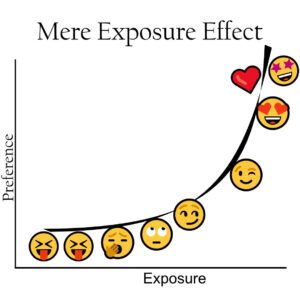
The Mere Exposure Effect: A Psychological and Neuroscientific Analysis
The ‘Mere Exposure Effect’ is a psychological phenomenon that explains why people tend to develop a preference for things merely because they are familiar with them. This effect, first proposed by Robert Zajonc in 1968, suggests that repeated exposure to a stimulus increases our liking for it, even without conscious recognition.
 Psychological Principles of the Mere Exposure Effect
Psychological Principles of the Mere Exposure Effect
The mere exposure effect operates on the principle that familiarity breeds liking. The more we are exposed to something, the more we tend to like it. This is because repeated exposure can enhance our perception of safety and reduce uncertainty about the stimulus. It’s a logarithmic relationship; the initial exposures have a more significant impact on our preferences than later ones.
Neuroscience Behind the Mere Exposure Effect
Neuroscientific studies have shown that certain brain regions are activated when we are exposed to familiar stimuli. These include the amygdala, which is associated with emotional processing, and the hippocampus, which plays a role in memory formation. When we encounter something familiar, these areas of the brain help us process the stimuli as safe and positive, thereby increasing our liking for them.
Therefore, there may be correlations between uncertain environments and the mere exposure effect, that is, if one finds themselves in an uncertain environment, they may be more prone to become endeared to something which is deemed safe/positive thereby allowing mass-marketing/inundation to circularly breed fandom.
Therefore, be mindful that in uncertain times you may be more likely to become enamored with something simply because it is safe, not because of genuine interest.
Susceptibility to the Mere Exposure Effect
Not everyone is equally susceptible to the mere exposure effect. Factors such as individual differences in personality, initial attitudes towards the stimulus, and the context of exposure can influence the extent to which a person is affected by this phenomenon. For instance, people with higher levels of anxiety may show stronger mere exposure effects because the familiarity provides a sense of comfort and security.
Brain Activation During Mass Marketing and Advertisements
Mass marketing and advertisements often leverage the mere exposure effect to influence consumer behavior. Research using functional magnetic resonance imaging (fMRI) has found that deceptive advertising can activate specific regions of the brain, such as the precuneus, which is involved in conscious attention, and the superior temporal sulcus (STS) and temporoparietal junction (TPJ), which are linked to theory-of-mind reasoning. This suggests that our brains are actively trying to discern the truth behind marketing claims.
Conclusion
The mere exposure effect is a powerful psychological principle with a strong neuroscientific basis. It highlights how familiarity can shape our preferences and behaviors, often without our conscious awareness. Understanding this effect can provide insights into consumer behavior, interpersonal attraction, and even our own personal preferences.
This is an important topic. We are talking about changing how people feel about other people, products and even ideas, simply through the practice of inundation. Never before has it been more important to practice the art of unplugging and detaching oneself from the medium-of-market. The truth is that when they put food on the table, most of us will eventually eat it, even if we didn’t want or like it in the first place. So next time you find yourself mid-course, stop and ask yourself if you’re consuming because you’re hungry or because they kept jamming it down your throat.
The Daily Endeavour
It’s okay to like a product (be it an item, icon or person) that is mass marketed, however, take time to ask yourself: Why do I like this person/object/item? Let your interests be the result of your unique self, not inundation from marketing.
